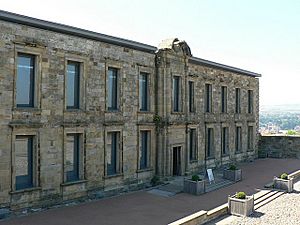Cholmley House facts for kids
Cholmley House, also called Whitby Hall, is a special building in North Yorkshire, England. It stands right next to the amazing ruins of Whitby Abbey. This grand house was built a long time ago, in 1672, by a man named Sir Hugh Cholmeley. His family had bought the land and the Abbey ruins after the Abbey was closed down in 1539. Before building Cholmley House, the family lived in the Abbey's old gatehouse.
Contents
Discovering Cholmley House
Cholmley House was originally designed as a banqueting house. This means it was a place for big parties and fancy meals. It had a square courtyard in front, which is now called the Stone Garden. This garden holds a copy of a famous ancient statue called the Borghese Gladiator. Sir Hugh Cholmeley, who built the house, owned another copy of this very statue.
A Look Back: Building and Early Life
The Cholmeley Family's New Home
The Cholmeley family had lived near Whitby Abbey for many years. After the Abbey was closed in 1539, they gained control of the land. For over a century, they lived in the Abbey's old gatehouse. Then, in 1672, Sir Hugh Cholmeley decided to build a brand new, impressive home. This new home was Cholmley House. It was a grand place for entertaining guests and showing off the family's importance.
Changes Over Time: Decay and Restoration
From Grand Home to Ruin
In 1743, the Cholmeley family inherited other large estates. They decided to move their main home to Howsham Hall. This left Cholmley House empty and unused. Over time, the house began to fall apart. A big storm in 1790 caused a lot of damage. The roof of the north side of the house was blown off. Because of this, the entire north part of the building had to be pulled down. Only the main hall of the house remained standing. Even this part continued to decay.
Saving the Historic Walls
Later, the Strickland family took ownership of the house. They saw its historical value. In 1866, they added strong arches inside the building. These arches helped to hold the walls up and stop them from collapsing. In 1936, the Ministry of Works took over Cholmley House and the Abbey ruins. They replaced the old arches with new, stronger ones. In 1984, the house was transferred to English Heritage. This organization looks after many historic sites in England.
Cholmley House Today: A Visitor Hub
Today, Cholmley House has a new and important purpose. It serves as the main visitor center for Whitby Abbey. The design studio Stanton Williams helped to redesign the building. It now includes a museum, a shop, and a reception area for visitors. This means people can learn about the Abbey's history and buy souvenirs. The newly restored Cholmley House was officially reopened on March 30, 2002. David Hope, who was then the Archbishop of York, attended the reopening ceremony.


